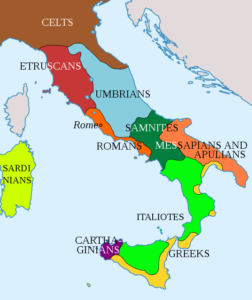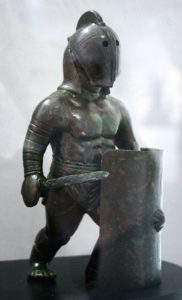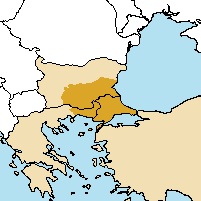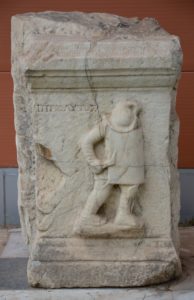Entertainers
11 Ethnic Varieties of Gladiators
Kyla Ip
Learning Objectives
In this section you will learn about
- Types of gladiators that were named after enemies of the Romans
- How these types of gladiators changed over time to reflect how the Romans’ conflicts and their enemies changed
- How this could make gladiators appear even more unRoman
‘ETHNIC’ GLADIATORS
One way that the Romans could mark gladiators as specifically unRoman is through the use of ethnic types of gladiators named after enemies of Rome, who fought with some Romanized[1] version of their traditional weapons and fighting styles. In creating gladiators of this type to fight for them the Romans tried to mark out those in the ring as different than them, and as more deserving of the humiliation of fighting for others’ entertainment.
Rome did not become an empire overnight: first they fought a number of wars with various peoples around them, some of them very similar in culture and language. One Italian tribe they fought was the Samnites, whom the Romans conquered early on in their expansionist phase.[2]

THE SAMNITE GLADIATORS
One such type was the Samnite, one of the oldest type of gladiators we hear of, but one that later died out. The Samnites was the name given to peoples of Samnium in southern Italy; the Romans conquered them in a long process and a sequence of three wars in the 4th and 3rd centuries BCE, which ended in 290 BCE. However, there were still tensions and the Samnites fought with other Italian allies of Rome in the Social War, the war between Rome and her allies that ended in 87 BCE, and were nearly wiped out in the process. After that their territory was devastated and depopulated and did not recover.
Here is Livy’s account of the origin of the Samnite gladiator. It is noteworthy that the equipment of the Samnite gladiators derives from the Samnite military. This inscription is the earliest reference of Samnite gladiators: in 308 BCE after the Second Samnite War:
There were two divisions; one had their shields plated with gold, the other with silver. The shield was made straight and broad at the top to cover the chest and shoulders, then became narrower towards the bottom to allow of it being more easily moved about. To protect the front of the body they wore coats of chain armour; the left leg was covered with a greave, and their helmets were plumed to give them the appearance of being taller than they really were. The tunics of the men with gold plated shields were in variegated colours, those with the silver shields had tunics of white linen….They looked upon those things as a spoil for the enemy rather than a defence for the wearer, resplendent enough before a battle but soon stained and fouled by wounds and bloodshed. ….Now the Samnites took to flight, and soon the plain was filled with shining armour and heaps of bodies. At first the terrified Samnites found shelter in their camp, but they were not able even to hold that; it was captured, plundered, and burnt before nightfall…. Whilst the Romans made use of this armour to honour the gods, the Campanians, out of contempt and hatred towards the Samnites, made the gladiators who performed at their banquets wear it, and they then called them “Samnites.”
Livy, History of Rome 9.40.
The Samnite type of gladiator was extremely popular in the Late Republic, but disappears after that. However, notice that in the above Livy places the first gladiators outside Rome, among the Campanians. Campania is a region in the South of Italy that includes Naples, which was at that time a Greek city. The Romans, according to Livy, do the good thing and give the armour to the gods to thank them for their victory, but the UnRoman Campanians just use the armour for their pleasure. Romans were convinced that Campanians were addicted to pleasure and soft, so this allowed them to contrast that with their manly, reverent selves. This probably strikes some of you as ironic, given the popular depiction of Romans in any movie about gladiators.

They carried a short sword (gladius) and a rectangular shield called a scutum. A helmet with a crest and a feathered visor (galea), and left leg greaves (ocrea) offered them protection.
THE GALLIC GLADIATORS
The peoples of Gaul (a region that roughly covered modern France and Belgium) proved to be a formidable foe of Rome, as demonstrated when they sacked the city in 390 BCE. Here a later historian gives a short account.
At an early period the Gauls waged war against the Romans, took Rome itself, except the Capitoline Hill and burned it. Camillus,[3] however, overcame and expelled them.
Appian, Roman History (From an Epitome) 7
They were feared by the Romans until conquered by Julius Caesar’s military campaign there in the 50s BCE. The devastation that Caesar’s campaign caused in Gaul and the number of people he killed and enslaved can barely be imagined. Here is one short reckoning of the deaths:
The latest and greatest war of the Romans against the Gauls was that waged under the command of Caesar, for, in the ten years that he held command there, he fought with more than 4,000,000 barbarians, taken all together. Of these 1,000,000 were captured and as many more slain in battle. He reduced to subjection 400 tribes and more than 800 towns, which had either revolted from their allegiance or were conquered for the first time.
Appian, Roman History (From an Epitome) 20a
As Gaul became deeply integrated into the empire and a wealthy province providing many members of the Roman elite and military the Gallic gladiator were renamed as the murmillo to reflect the changing attitudes towards the Gauls.
The second inscription says: “When the retiarius fights against the murmillo, he sings ‘I don’t hunt you, I hunt fish. Why are you running away from me, Gaul?’, since the type of armour murmilliones wear is Gallic, and the murmilliones used to be called Gauls before, and that is why they have images of cockerels and fish .”
Paulus ex Festo p.358L[4]
THE THRACIAN GLADIATORS/THRAEX
The Romans encountered the Thracians, who lived in the southeastern Balkans – between Bulgaria, Greece and Turkey – in the Mithridatic Wars in the 1st to 2nd century BCE. To the Romans the Thracians were wild and savage, a perspective they shared (and probably absorbed from) the Greeks, on whose borders the Thracians lived.

The Thraex had a small rectangular shield (parmula), two leg greaves, a curved scimitar (sica), a feathered helmet carved with the relief of a griffin’s head, a right armguard (manica) and a loincloth.[5] In combat, it was paired with the hoplomachus,[6] murmillo, or another Thracian gladiator.

The first gladiators to appear at Rome were Thracians,[7] and they were immensely popular until the end. This means that they entered the arena and appealed to Romans, long before and after they fought directly and seriously with them as a people.[8] So something about this fighter was deeply appealing to the Romans.
The Romans, however, also absorbed Greek attitudes towards Thrace, which were not very positive: they considered them barbarians and fit only to be slaves, even if they were also a terrifying enemy at times. In the following passages, three authors writing in Greek, Ptolemy, Herodotus and Thucydides[9] offer their opinions on the Thracian people. On one hand they are perceived to be somewhat worthy of respect because they share values with the Greeks; whereas in the other, they are seen as the “Other” with low morals and are a warmongering people. Although all three were Greek, Ptolemy (see below) was most likely a Roman citizen,who lived in 2nd century CE Alexandria in Egypt, while Herodotus and Thucydides lived and wrote in the 5th century BCE.
Herodotus gives his opinions of them in a number of places:
The Thracians are the biggest nation in the world, next to the Indians. If they were under one ruler, or united, they would, in my judgment, be invincible and the strongest nation on earth. Since, however, there is no way or means to bring this about, they are weak. The Thracians have many names, each tribe according to its region, but they are very similar in all their customs, save the Getae, the Trausi, and those who dwell above the Crestonaeans.4. As for the Getae, who claim to be immortal, I have already given an account of their practices.1 The Trausi, who in all else conform to the customs of other Thracians, do as I will show at the times of birth and death. When a child is born, the kinsmen sit around it and lament all the ills that it must endure from its birth onward, recounting all the sorrows of men. The dead, however, they bury with celebration and gladness, asserting that he is rid of so many ills and has achieved a state of complete blessedness.[10]. 5. Those who dwell above the Crestonaeans have yet different practices. Each man has many wives, and at his death there is both great rivalry among his wives and eager contention on their friends’ part to prove which wife was most loved by her husband. She to whom the honor is adjudged is praised by men and women alike and then killed over the tomb by her nearest of kin. After the killing she is buried with the husband. The rest of the wives are greatly displeased by this, believing themselves to be deeply dishonored.[11]. 6. Among the rest of the Thracians, it is the custom to sell their children for export[12] and to take no care of their unmarried girls, allowing them to have intercourse with any man they wish. Their wives, however, they strictly guard, and buy them for a price from the parents. 2 To be tattooed is a sign of noble birth, while to bear no such marks is for the lower people. The lazy person is most honored, the farmer most scorned; he is held in highest honor who lives by war and robbery.
Herodotus, Histories 5.3-6.
All the qualities that Herodotus describes as Thracian would have been deeply unsettling to many Romans as well as the Greeks, including not getting a dowry with your wife and instead having to pay a bride price.
The following comes from a work on astrology and philosophy written in second century CE by Claudius Ptolemy, a Greek resident of Alexandria in Egypt, who had a Roman first name (and thus may have been a Roman citizen). In it he discusses the various star signs and how they relate to different ethnic groups:
The parts of this quarter which are close to the centre of the inhabited world, Thrace, Macedonia, Illyria, Hellas, Achaia,[13] Crete…[14] have in addition familiarity with the south-east triangle, Taurus, Virgo, and Capricorn, and its co‑rulers Venus, Saturn, and Mercury.[15] As a result the inhabitants of those countries are brought into conformity with these planets and both in body and soul are of a more mixed natire. They too have qualities of leadership and are noble and independent, because of Mars;[16] they are liberty-loving and self-governing, democratic and framers of law, through Jupiter;[17] lovers of music and of learning, fond of contests and clean livers, through Venus; social, friendly to strangers, justice-loving, fond of letters, and very effective in eloquence, through Mercury; and they are particularly addicted to the performance of mysteries, because of Venus’s occidental aspect. And again, part by part, those of this group who live in the Cyclades and on the shores of Asia Minor and Cyprus are more closely familiar to Taurus and Venus. For this reason they are, on the whole, luxurious, clean, and take care of their bodies. The inhabitants of Hellas, Achaia, and Crete, however, have a familiarity with Virgo and Mercury, and are therefore better at reasoning, and fond of learning, and they exercise the soul in preference to the body. The Macedonians, Thracians, and Illyrians have familiarity with Capricorn and Saturn, so that, though they are acquisitive, they are not so mild of nature, nor social in their institutions.[18]
Ptolemy, Tetrabiblos 2.3.59-69
As a supposedly wild and savage nation, fond of tattooing their bodies (unlike the Romans and Greeks)[19] and living a life of murder and robbery, you can see why they might have appeal to the Romans in the arena. To them, like the Greeks, they could be seen as wild people, who already lived a life of violence, now made to fight for their masters.
Thracians were so popular they appear in an ancient dream book, a book that explains the meaning of various dreams Romans might have. Notice that the Thracian not only represent wealth and cunning, but is aggressive (wants to be first and advances).
In Artemidorus’ Dream Book where he explains different imagery in dreams, he notes what the different aspects of the Thracian gladiator mean should someone see one in their dreams.
I have often observed that this dream [of fighting gladiators] indicates that a man will marry a woman whose character matches the weapons that he dreams he is using or the type of opponent he is fighting…For example, if a man fights a Thracian he will marry a rich, cunning wife, fond of being first. She will be rich because the Thracian’s body is covered all over by his armour; cunning because his sword is curved, and fond of being first because the Thracian advances when he fights.
Artemidorus, Dream Book 2.32
The Emperor Caligula was fond of appearing as a Thracian fighter. In his case, it is hard to know if he picked that type of fighter because its ethnic connotations (as wild and dangerous) appealed to him or for some other reason:
He also devoted himself with much enthusiasm to arts of other kinds and of great variety, appearing as a Thracian gladiator, as a charioteer, and even as a singer and dancer, fighting with real weapons[20] and driving in circuses built in various places; so carried away by his interest in singing and dancing that even at the public performances he could not stop himself from singing with the tragic actor as he delivered his lines, or from openly imitating his gestures by way of praise or correction.
Suetonius, Caligula 54
Further Reading
Doberstein, William. The Samnite Legacy: An Examination of the Samnitic Influences Upon the Roman State. 2014. University of Lethbridge Research Repository. Retrieved from
https://opus.uleth.ca/bitstream/handle/10133/3499/Doberstein_William_MA_2014.pdf
An MA thesis that is quite accessible and also available online. (MA and PhD theses are usually available online now- so they are a valuable resource, especially if recent, because they will start by providing you with a summary of the subject at the time, along with references if you want to dig further. While these are not published works in the normal sense, they have had to be submitted, read, and passed by an academic committee from that field.)
A note from the student reviewer: “Content-wise, the first chapter of Doberstein’s thesis paper proved the most useful in dealing with the origins of the Samnite gladiator. It is directed towards an audience that are native English-speakers. But for those with English as their second language, the sentences are short and easy to understand. The second chapter may be helpful in discerning where the words pilum and scutum came from, if one is interested. However, because this chapter also details the Samnitic origins of the maniple system, some knowledge may be needed for knowing the early history, workings of the Roman military, and its terminology. Thus, for students, ESL or not, this chapter may be hard to understand. The third chapter can be omitted.”
Jankovic, Marko A. 2014. “Violent ethnicities: Gladiatorial spectacles and display of power”, in The Edges of the Roman World Editors: Marko A. Jankovic, Vladimir D. Mihajlovic, Stasa Babic. Cambridge: 48-60
Any basic work on gladiators will discuss the types, particularly the Tracian (Thraex) gladiators, because they were so popular, but not discuss why these types might have appealed. This is an accessible article (it begins by explaining the history and function of the games and does not expect you to know the background) that goes into the history of and reasons why these types came into existence and were so popular.
Rebecca F. Kennedy, C. Sydnor Roy and Max L. Goldman. 2013. trans. Race and Ethnicity. Indianapolis.
A collection of ancient primary sources on race and ethnicity; if you want to read more about what the Greeks and Romans thought about the various ethnic groups these gladiators references, then this would be the place to go.
Useful websites for general information on the gladiator types mentioned above:
http://www.tribunesandtriumphs.org/gladiators/samnites.htm
http://www.tribunesandtriumphs.org/gladiators/gallus.htm
http://www.tribunesandtriumphs.org/gladiators/thracian.htm
http://penelope.uchicago.edu/~grout/encyclopaedia_romana/gladiators/thraex.html
Primary sources:
Livius.org. “Appian, Samnite Wars 1.” Livius.org. Last modified 3 January 2016. https://www.livius.org/sources/content/appian/appian-samnite-wars-1/
Buterfield, Bruce J. “Livy’s History of Rome: Book 9.” Mcadams.posc.mu.edu. Last modified 1996 http://mcadams.posc.mu.edu/txt/ah/livy/livy09.html
Thayer, Bill. “Strabo’s Geography Book V Chapter 4.” Penelope.uchicago.edu. Last updated 4 September 2017. http://penelope.uchicago.edu/Thayer/E/Roman/Texts/Strabo/5D*.html
Livius.org. “Appian, Gallic Wars 1.” Livius.org. Last modified 3 January 2016. https://www.livius.org/sources/content/appian/appian-gallic-war-4/
Livius.org. “Appian, The Mithridatic Wars 20.” Livius.org. Last 3 December 2018. https://www.livius.org/sources/content/appian/appian-the-mithridatic-wars/appian-the-mithridatic-wars-20#98
Media Attributions
- 604px-Italy_400bC_en.svg
- Musée_Arles_antique_801 © Michel Wal
- Thrace_modern_state_boundaries
- Funerary_carved_relief_of_a_Roman_gladiator_found_at_Ephesus,_Ephesus_Museum,_Turkey_(17089900370)
- The Romans did not really go for accuracy in this, however; it was a very Roman centred vision of theirfoes. ↵
- While some of these gladiators were originally presumably prisoners of war from the Samnites or Thracians (to name two types), they were also drawn from prisoners from other cultures and peoples who were made to learn a new way of fighting. ↵
- Known as the “Second Founder of Rome”, Marcus Furius Camillus was a Roman military general and later on, a five-time dictator. He died in 365 BCE. ↵
- Because this is a tricky source to find sometimes here is the Latin: Retiario pugnanti adversus murmillonem, cantatur: “Non te peto, piscem peto. Quid me fugis, Galle?” quia murmillonicum genus armaturae Gallicum est, ipsique murmillones ante Galli appellabantur; in quorum galeis piscis effigies inerat. ↵
- Bear in mind the Romans were not going for historical or ethnographical accuracy in the way they kitted out these fighters; it was enough to gesture to some sort of vaguely similar fighting style, as the majority of Romans would not exactly be experts or demand accuracy. ↵
- Itself a variety of ethnic gladiator modelled vaguely on a Greek hoplite soldier. ↵
- See the previous section for details. ↵
- This page gives you some idea of what Roman Thrace was like so you can understand what the region was like while Romans were watching them fight in the arena. ↵
- The two authors were considered classics and were read by many educated Romans, sometimes as part of their education; the first wrote under the Roman empire on a very popular topic, astroloy. ↵
- This sort of attitude about death was common also to many Greek nations. ↵
- I strongly suspect that if this happened, that this was not the case and no one actually wanted to be killed. ↵
- The Greeks, instead, practiced infanticide with children they did not want to raise. ↵
- Hellas refers to Northern Greece, and Achaia to the Peloponesse where cities like Athens, Corinth, and Sparta were situated. ↵
- He goes on to reference other places like various Greek islands. ↵
- These last three are gods. ↵
- The god of war. ↵
- The main god of the pagan pantheon, he was thought to be closely connected to ruling and the qualities of rulership and law. ↵
- By this, Ptolemy is referring to the tribal nature of these societiies, and their lack of urban living in a way that the Greeks and Romans thought was 'civilized'. ↵
- Which is not to say that some Romans and some Greeks did not have tattoos; it just means that they had a heavy social stigma attached. ↵
- As opposed to wooden ones, so you didn't accidentally lop someone's head off because you had no idea what you were doing. ↵
Titus Livius Patavinus came from Patavium (modern Padua), a city in the north of Italy. He moved to Rome in the 30s BCE but never seems to have played a role in public life. He wrote a massive history of Rome from its founding up until Livy’s own times. Much of it is lost and only exists in summaries or quotations; of the original 142 books we have 35, covering the early history of Rome and the Second Punic War.
Sometimes called the Capitol, this was where the temple of Jupiter Optimus Maximus was located, as well as other religious buildings.

